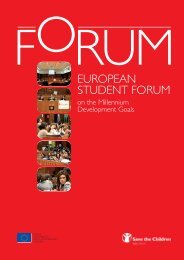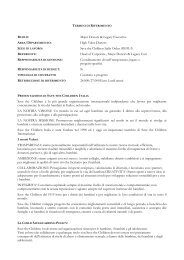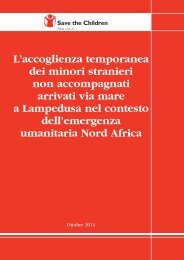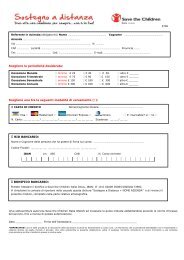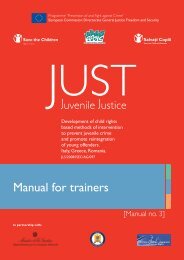FINAL REPORT - Save the Children Italia Onlus
FINAL REPORT - Save the Children Italia Onlus
FINAL REPORT - Save the Children Italia Onlus
Create successful ePaper yourself
Turn your PDF publications into a flip-book with our unique Google optimized e-Paper software.
IIPART50<strong>FINAL</strong> <strong>REPORT</strong>Development of a Child Rights Methodology to Identify and Support Child Victims of TraffickingBorder Police General Inspectorate:• notifies <strong>the</strong> appropriate border point of <strong>the</strong> child’s return and his/her identity to facilitate <strong>the</strong>child legal guardians’ access to <strong>the</strong> child;• notifies <strong>the</strong> nearest police precinct of <strong>the</strong> child’s identity (police precinct near <strong>the</strong> Counsellingand Assistance Centre);• designated border police officers inform <strong>the</strong> child of <strong>the</strong>ir right, as a victim, to file a complaintagainst <strong>the</strong> persons which trafficked <strong>the</strong>m and of <strong>the</strong>ir role in <strong>the</strong> legal proceedings (<strong>the</strong> childand <strong>the</strong> officer in charge sign affidavits);• if <strong>the</strong> victim does not speak Romanian, a translator should provide assistance;• designated officers file <strong>the</strong> victim’s statement on <strong>the</strong> events, <strong>the</strong> perpetrator and o<strong>the</strong>r detailsrelevant to <strong>the</strong> law enforcement agencies (taking into account <strong>the</strong> victim’s state of mind andphysical condition);• at <strong>the</strong> victim’s request, she/he will be placed in an assistance and counselling centre, ei<strong>the</strong>r onenominated by him/her or <strong>the</strong> nearest to his/her home town, taking into account <strong>the</strong> vacancylevel of <strong>the</strong> centre;• The child’s legal guardian or o<strong>the</strong>r designated person will take <strong>the</strong> child into custody andaccompany him/her to his/her area of residence or to a specialised centre for unaccompaniedchildren and trafficking victims. The centre is subordinate ei<strong>the</strong>r to <strong>the</strong> General Directorate forSocial Assistance and Child Protection or to an authorised private institution.General Direction for Social Assistance and Child Protection:• nominates a representative which will accompany <strong>the</strong> child to his/hers area of residence or to aspecialised centre for unaccompanied children and for trafficking victims in his/her area ofresidence or in one of <strong>the</strong> border counties if <strong>the</strong> child’s residence is unknown (to ensure that <strong>the</strong>child is taken into custody, she/he has a legal representative and is accompanied by an adult);• according to <strong>the</strong> law, <strong>the</strong> general director or <strong>the</strong> executive director of <strong>the</strong> General Directoratefor Social Assistance and Child Protection agrees upon <strong>the</strong> appropriate emergency protectionmeasures of <strong>the</strong> child (who is accompanied to <strong>the</strong> centre);• if this is not possible, <strong>the</strong> director must immediately notify <strong>the</strong> National Authority for <strong>the</strong>Protection of Child’s Rights, which will delegate <strong>the</strong>se responsibilities to <strong>the</strong> Bucharest District2 General Direction for Social Assistance or to <strong>the</strong> local General Directorate for SocialAssistance and Child Protection (<strong>the</strong> county where <strong>the</strong> border point is located);• <strong>the</strong> child is accompanied to <strong>the</strong> specialised centre for unaccompanied children or for traffickingvictims. These centres are under <strong>the</strong> supervision of <strong>the</strong> local General Directorates for SocialAssistance and Child Protection. There she/he will receive assistance as stipulated by <strong>the</strong> lawuntil he/she is ei<strong>the</strong>r taken by his family or by <strong>the</strong> General Directorate for Social Assistanceand child protection from his county of residence;• <strong>the</strong> local General Directorate for Social Assistance and Child Protection from <strong>the</strong> child’s area ofresidence will make all necessary arrangements for <strong>the</strong> child’s reintegration into <strong>the</strong> family (i.e.assesses <strong>the</strong> family and analyses <strong>the</strong> reintegration opportunities, solves legal issues - identity papersor o<strong>the</strong>r documents which certify <strong>the</strong> professional skills, <strong>the</strong> educational or professionalreintegration and any health problems) and monitors <strong>the</strong> case for a minimum period of 3 months.A toll-free hotline for children is available in each local General Directorate for Social Assistanceand Child Protection (GDSACP) where complaints of child abuse or trafficking can be made.National Authority for <strong>Children</strong>’s Rights Protection (NACRP):• forwards any relevant documents on <strong>the</strong> returned child’s situation to competent foreignauthorities requesting information;• observes compliance with minimum compulsory requirements of <strong>the</strong> centres (providingprotection and emergency assistance to children, victims of trafficking;• monitors <strong>the</strong> cases, jointly with <strong>the</strong> National Authority against People Trafficking.Transit CentresThe Regional and Transit Centres provide assistance in cases of sexual and labour exploitation,crime, organ harvesting, internal or external trafficking (in compliance with <strong>the</strong> minimummandatory standards for <strong>the</strong> protection and assistance of victims of trafficking in human beings).The Bucharest Pilot Centre has <strong>the</strong> responsibility for <strong>the</strong> coordination of <strong>the</strong> activity of all transitcentres, monitoring <strong>the</strong> situation of returned children and setting up a national database of casesof trafficked children.<strong>FINAL</strong> <strong>REPORT</strong>Development of a Child Rights Methodology to Identify and Support Child Victims of TraffickingA. When <strong>the</strong> child enters <strong>the</strong> country through a different border point (not Otopeni/Henri Coanda)and is taken into custody by a representative of <strong>the</strong> Transit Centre or a GDSACP representativefrom his/hers area of residence <strong>the</strong> practice followed is <strong>the</strong> following:• an employee of <strong>the</strong> Transit Centre is nominated by <strong>the</strong> local GDSACP where <strong>the</strong> child lives tomeet <strong>the</strong> child victim, represent him/her and accompany <strong>the</strong> returned child. The localGDSACP also provides <strong>the</strong> child’s personal data to <strong>the</strong> border point;• <strong>the</strong> nominated person arrives at <strong>the</strong> Border Point to take <strong>the</strong> child into custody;• border police officers immediately carry out <strong>the</strong> border procedures and <strong>the</strong> child is handed overto an adult who accompanies him/her to <strong>the</strong> Transit Centre, where she/he undergoes a medialexamination and is admitted into an assistance, protection and reintegration programme;• GDSACP’s General Director or Executive Director in <strong>the</strong> county where <strong>the</strong> Transit Centre islocated agrees upon <strong>the</strong> emergency placement of <strong>the</strong> unaccompanied child and authoriseshis/her admission to <strong>the</strong> Transit Centre;• <strong>the</strong> Transit Centre notifies <strong>the</strong> NACRP of <strong>the</strong> child’s situation and forwards relevant caseinformation to <strong>the</strong> Pilot Centre (to be entered into <strong>the</strong> national database);• according to Law 272/2004, <strong>the</strong> Transit Centre provides accommodation and specialistassistance for a period of 15 days;• if no solution for <strong>the</strong> child’s reintegration into his/her family is found during this time period,<strong>the</strong> child is admitted into a residential care institution. The child may continue to receivepsychological assistance and social protection in <strong>the</strong> Pilot Centre;• <strong>the</strong> accommodation period can be extended up to 3 months or throughout <strong>the</strong> entire trialperiod at <strong>the</strong> request of law enforcement representatives.B. When <strong>the</strong> child receives assistance at <strong>the</strong> Pilot Centre or in a Transit Centre outside his/her area ofresidence <strong>the</strong> practice followed is <strong>the</strong> following:• an employee of <strong>the</strong> Transit Centre is nominated by <strong>the</strong> local GDSACP where <strong>the</strong> child lives totake <strong>the</strong> child into custody and accompany him/her to <strong>the</strong> Centre;• <strong>the</strong> delegated person or <strong>the</strong> legal guardian accompanies <strong>the</strong> child from <strong>the</strong> Pilot or TransitCentre to his/her family or to ano<strong>the</strong>r Transit centre in his/her area of residence;• <strong>the</strong> unaccompanied child is admitted to <strong>the</strong> Transit Centre (emergency placement) or s/hebenefits of o<strong>the</strong>r protection measures, taking into account his/her situation;• <strong>the</strong> Transit Centre notifies <strong>the</strong> NACRP of <strong>the</strong> child’s situation and forwards on his/her personaldata;• <strong>the</strong> Transit Centre provides accommodation and specialised assistance for a period of 15 days,according to <strong>the</strong> law 272/2004;• if no solution for <strong>the</strong> child’s reintegration into his/her family is found during this time period,<strong>the</strong> child is admitted into a residential care institution. The child may continue to receivepsychological assistance and social protection in <strong>the</strong> Pilot Centre;• <strong>the</strong> accommodation period can be extended up to 3 months or throughout <strong>the</strong> entire trialperiod at <strong>the</strong> request of law enforcement representatives.Regional Transit Centres and Emergency Care Centres for abused/trafficked childrenThese units provide temporary support and protection to child victims, including victims ofinternal trafficking. In particular:• <strong>the</strong>y provide shelter and specialised assistance for a period of 15 days;• <strong>the</strong>y are subordinate to <strong>the</strong> local GDSACP and represent only one step of <strong>the</strong> intervention (anemergency measure);• once <strong>the</strong> child passes <strong>the</strong> medical exam, s/he is allowed to be integrated in a residential carefacility (<strong>the</strong> child’s health condition must allow for his/her integration without affecting <strong>the</strong>o<strong>the</strong>rs);• <strong>the</strong> child has no transmittable diseases: hepatitis B or C, HIV, acute tuberculosis, acute mentalor somatic diseases;• if <strong>the</strong> child is in bad health, s/he will be admitted into a children’s hospital and <strong>the</strong>n, oncehis/her condition improved, s/he is taken into custody by one of <strong>the</strong> Centres.In <strong>the</strong> Centre:• <strong>the</strong> child is provided with basic accommodation and food;• accommodation is provided taken into account <strong>the</strong> child’s age and gender;• <strong>the</strong> children are informed of <strong>the</strong> centre’s internal rules, and of <strong>the</strong>ir rights and responsibilities;IIPART51



